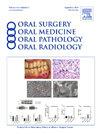Incidental finding of a rare persistent craniopharyngeal canal: a case report and literature review
IF 2
3区 医学
Q2 DENTISTRY, ORAL SURGERY & MEDICINE
Oral Surgery Oral Medicine Oral Pathology Oral Radiology
Pub Date : 2025-02-04
DOI:10.1016/j.oooo.2024.11.047
引用次数: 0
Abstract
Clinical Presentation
A 22-year-old female patient presented to our oral and maxillofacial surgery clinic for mandibular prognathism and to have Le Fort I orthognathic surgery. The patient has multiple congenital anomalies affecting the skull and face, including craniosynostosis, frontonasal dysplasia with a midline cleft palate and lip, orbital deformities, and hypertelorism. Cone beam computed tomography scanning was taken for preoperative evaluation. Incidentally, it showed a well-defined vertical bony conduit extending from the floor of sell turcica to the roof of the nasopharynx with a corticated and intact margin. The bony conduit was elliptical on the axial section, and exhibited a 2.42 mm diameter and a 4.95 mm length in the sagittal section.
Differential Diagnosis
Benign nonodontogenic cyst; Rathke cleft cyst (Rathke pouch migration), neurenteric cyst.
Diagnosis and Management
On the basis of the imaging characteristics and associated craniofacial anomalies, a diagnosis of type I persistent craniopharyngeal canal (CPC) was rendered. No treatment was required at this time, and the patient was advised to follow up as necessary.
Conclusion
Persistent CPC is a rare congenital abnormality resulting from the failure of regression of Rathke pouch during the prenatal period, with a prevalence of up to 0.42%. According to our literature review, approximately 166 cases of have been documented since its initial report in 1949. Reported by Abele et al, the size of the defect can range from 0.7 mm to 31.0 mm and correlates with the severity and prognosis. Persistent CPC is associated with craniofacial anomalies (e.g., cleft lip and palate, ectopic adenohypophysis, cephalocele, tumors) and orbital malformations (e.g., optic atrophy, morning glory disc anomaly). Because of its rarity and potentially life-threatening conditions, accurate diagnosis and timely treatment are crucial. Cone beam computed tomography and magnetic resonance imaging are the recommended diagnostic modalities.
求助全文
约1分钟内获得全文
求助全文
来源期刊

Oral Surgery Oral Medicine Oral Pathology Oral Radiology
DENTISTRY, ORAL SURGERY & MEDICINE-
CiteScore
3.80
自引率
6.90%
发文量
1217
审稿时长
2-4 weeks
期刊介绍:
Oral Surgery, Oral Medicine, Oral Pathology and Oral Radiology is required reading for anyone in the fields of oral surgery, oral medicine, oral pathology, oral radiology or advanced general practice dentistry. It is the only major dental journal that provides a practical and complete overview of the medical and surgical techniques of dental practice in four areas. Topics covered include such current issues as dental implants, treatment of HIV-infected patients, and evaluation and treatment of TMJ disorders. The official publication for nine societies, the Journal is recommended for initial purchase in the Brandon Hill study, Selected List of Books and Journals for the Small Medical Library.
 求助内容:
求助内容: 应助结果提醒方式:
应助结果提醒方式:


